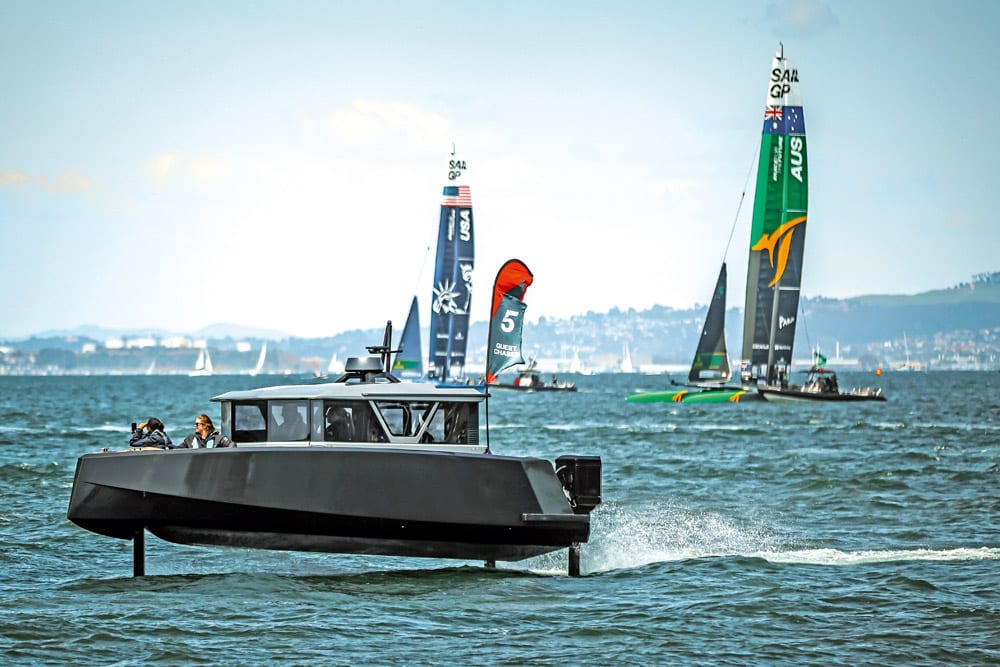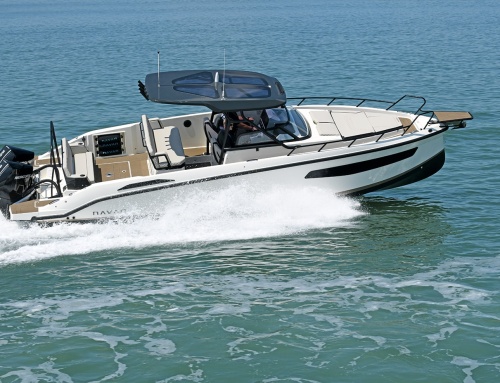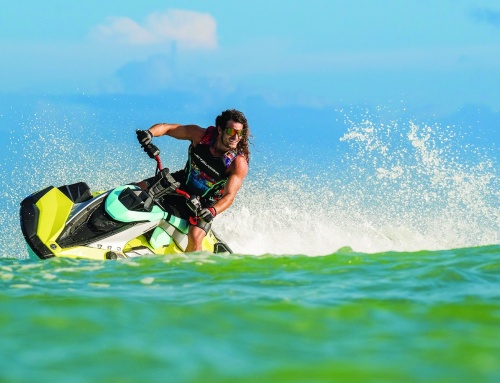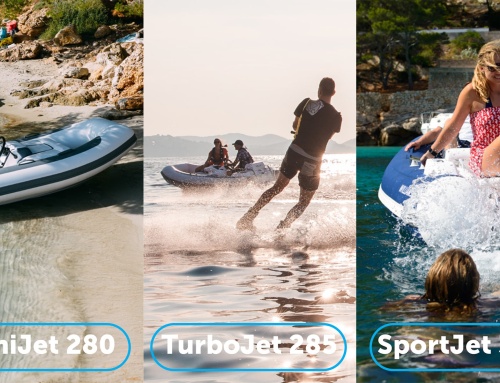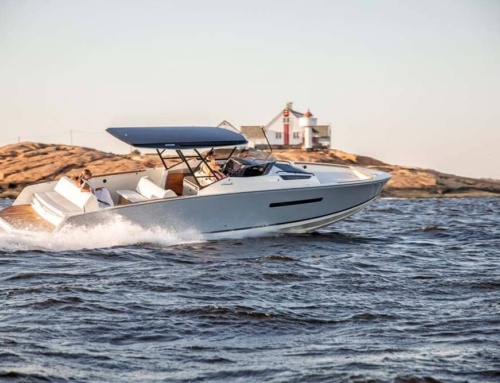Navier N30 – This futuristic foiling adventure craft is a step forward for electric boating.
Built from carbon fibre, the 35-knot Navier N30 appears to be the most realistic electric planing boat to date. Navier, based in California, are a venture-backed company led by a team of MIT, Berkeley and CMU graduates. All with experience in either aerospace, maritime autonomy or robotics, they have set out to create an electric boat that spends more time under power than receiving it. Their prototype vessels were developed in partnership with the America’s Cup and the Lyman-Morse boatyard in Maine – bringing together high-quality craftsmanship and Silicon Valley technology.

The N30 with foils deployed starting to transit from displacement to foiling speed.
The first production electric powerboat from this company is the all-carbon-fibre N30. The similarities with the 29ft Swedish Candela C-8 CC that we featured in Issue 183 are hard to ignore. This is not too surprising, given that foiling is the most efficient means of planing. This boat has two 90kW engines – the fossil fuel equivalent of twin 120hp engines – and is claimed to have a top speed of 35 knots. It is available with two battery capacities: the basic boat package comes with an 85kWh lithium-ion battery, while the standard and premium spec boats have 114kWh battery banks. The smaller battery gives the N30 a range of 45nm, while the larger one provides for up to 90nm at its cruising speed of 20 knots. For an electric boat this is impressive, and Navier claim that it is the longest range of any electric planing boat so far, helped by the fact that, being carbon fibre, it only displaces 2.5 tonnes. Though this range is likely to be a best-case scenario, it is still way ahead of any non-foiling electric planingcraft. In comparison, the Candela, with its single 75kW engine and a 69kWh battery, is claimed to have a range of 57 miles at 22 knots, and a top speed of 30 knots.

Styling is typically minimalistic.

The fit and finish is of a very high standard.
An overnight charge is needed with the standard AC charging system to get either battery back in shape from a safe maximum discharge level of 90%. With the premium-spec boat comes a fast DC charger, which cuts down the charging time substantially – in this case to 30 minutes.

Fast DC charging makes the Navier N30 very versatile.

The Navier display enables you to see your remaining range at a glance.
There is more to the equation than just foils and high-capacity lithium-ion batteries, however. HIRO is Navier’s proprietary ‘state-of-the-art aerospace flight control’ operating system, which in simple terms connects a network of sensors and software, providing a seamless smooth ride. This sounds very similar in concept to the flight computer-type system that Candela use, which deploys the foils in accordance with speed and sea conditions. When the Candela heels into a turn, the foils allow a degree of lean, and a motion sensor controls the foils to match the sea conditions. Looking at the aerospace and robotic expertise behind the N30’s development, I have little doubt that HIRO is no less effective. A push of the throttles provides a seamless transition from its displacement mode, with its foils fully raised, to the lowest foiling speed of 15 knots with the foils locked below the hull in their planing position. As you pile on the power, the boat will develop more lift, reaching a maximum height of 4ft above the water. The front foil sits recessed within a hull cut-out when not deployed, and the two aft foils are in effect outboard mounted and, like the bow foil, sit with the vertical foil struts standing prominently above the topsides when static or in displacement mode.

Foils up for beaching.
Interestingly, this boat has three operating modes: Eco mode is the most efficient, with the system optimising the foils for economical cruising; Comfort mode is exactly that and is aimed at providing easy driving for any level of experience; and Sport mode is unique, providing a hands-on driving experience for a foiling boat. The helmsman is given much greater control over how the boat responds. The maximum speed limit is increased to 35 knots, a higher running attitude is possible and the foils will respond in the turns, providing lean angles of up to 30 degrees. As Navier put it, ‘this is for people who might enjoy flying a fighter jet’.

The open version has a striking profile.
When it comes to berthing, this boat has two methods. Firstly, there’s the luxury of a joystick without thrusters. Instead, it independently vectors the thrust from the foil-mounted pods – in the same manner that outboard engines vector thrust. To what degree the pods can rotate has not been confirmed, but the N30 can move sideways via the joystick, so one can suppose that the pods have a wide arc of movement. Secondly, true to its futuristic character, it has an auto docking function – something not yet seen on a 30-footer. Auto docking uses advanced computer vision and additional sensors to estimate the position of the boat in relation to the intended berth, while compensating for external factors like wind and tide. Once berthed, this fully hands-free system holds position, giving the crew time to tie up.
In keeping with this craft’s green credibility, all decking is cork – a sustainable wood source. There are various extras, including a heads compartment, a sound system, a fridge and an app enabling you to monitor your N30 anywhere and upload the latest system software updates. There are also various upholstery options, as well as hull colour schemes and seating options.
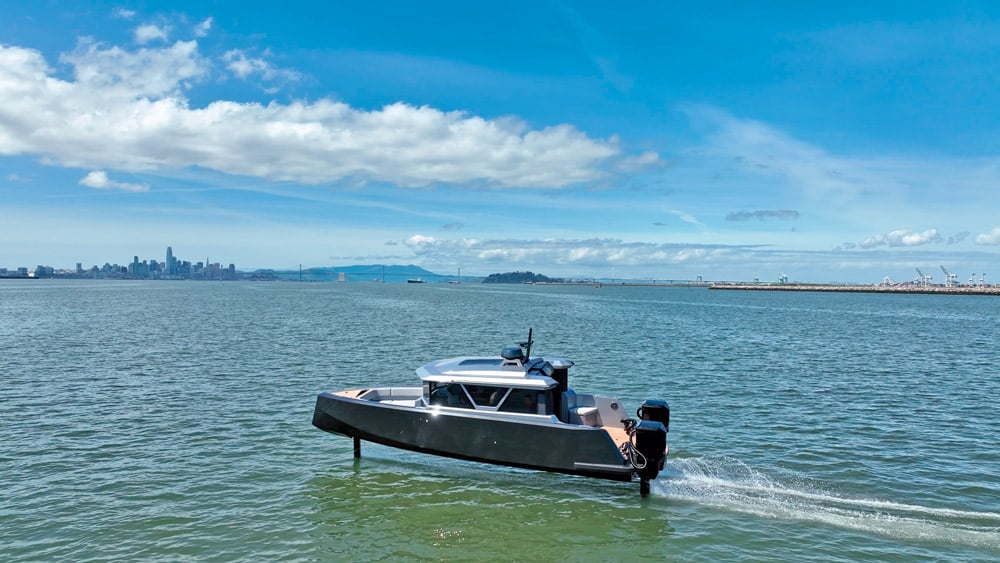
There are open, hardtop and cabin versions of the N30, available with different specification levels. The base level does not offer the larger battery capacity, so most will consider paying the extra $100,000 for the standard or another $225,000 for the premium spec. There are starting base prices of $375,000 for the open version and $550,000 for the cabin model.
Specifications
- LOA: 30ft
- Beam: 8ft 10in
- Draught: 2ft and 5ft 6in with foils deployed
- Engines: Twin 90kW electric motors
- Rating: 8 people
- Displacement: 2560kg
- Range: Up to 90nm
Contact
Have you read our article ‘Is electric boating green?’?

